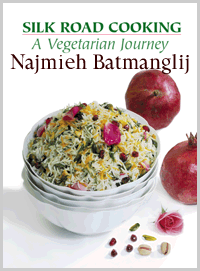Morteza Ardebili
December 25, 2005
iranian.com
The task of writing about an important and enduring ritual of a culture that has persisted over 3000 years is a daunting one.
In The Persian Wedding, however, Bijan Moridani has accomplished the task of carefully and delicately describing the wedding ritual that constitutes the core of the Persian institution of marriage. [See excerpt]
The Persian Wedding consists of four chapters, a bibliography, a glossary and a guide to pronunciation, and a guide to the colorful photographs that are contained in the work.
An important feature of the book is that its content is written in both English and Persian and is presented in two separate sections in the book.
While one chapter of the book is devoted to Zoroastrian wedding in recent past, the other three chapters of The Persian Wedding cover the wedding ritual in three different moments of Persian history (i.e., the current, the recent past, and the ancient Iran).
The most elaborate and longest is the first chapter, where Moridani skillfully describes the elements that compose the wedding ritual as a whole. The intention of the author is not to give a historical overview of the evolution of the ritual in question.
 Indeed, as Moridani himself indicates, there have not been significant changes in the ritual. The reason for this, perhaps, is the fact that the wedding ritual was embedded in, and informed by, the agrarian institutions of Persian society, which only recently have begun to shift toward industrial ones.
Indeed, as Moridani himself indicates, there have not been significant changes in the ritual. The reason for this, perhaps, is the fact that the wedding ritual was embedded in, and informed by, the agrarian institutions of Persian society, which only recently have begun to shift toward industrial ones.
It is important to mention that with such a shift in social institutions, the institution of marriage and the wedding ritual are bound to change as well. It is within this new historical epoch that The Persian Wedding will become an invaluable document that will preserve the tradition of the past for the future generations.
The Persian Wedding may not only serve as a valuable resource for familiarizing the Western readers with Persian culture, it can also help to bridge the conceptual and communication gap about marriage between the Iranian immigrants in the U.S. and their American-born children.
The book, of course, cannot reconcile by itself the Western and the Persian cultural categories in terms of which the Persian-born parents and their American-born children think about the marriage and gender relations. It can, however, enable the first generation of Iranian-Americans to understand the cultural foundation of their parents’ perspective on the institution of marriage and family.
The Persian Wedding is a very well-written book about the Persian wedding ritual and, in the opinion of this reviewer, must be found in every Persian household.
It is important to mention that the book is not about an isolated cultural ritual; it is, rather, about a set of organized cultural practices that are organically connected to, and, hence, an expression of, the totality of Persian culture.
Therefore, the real significance of the work that Moridani has so aptly produced should not be judged only by its apparent contribution; but also by the depth of Persian culture to which the book could be a point of entry.
EXCERPT from The Persian Wedding
 Khâstegâri (asking for her)
Khâstegâri (asking for her)
On a predetermined date, the young man and his family dress up and go to the young woman’s family's house. They are greeted warmly. Pastries are served. The girl enters the room carrying a tray of teacups and offers it to the guests. This is not an easy task. She is nervous and her hands are probably shaking...
Nâmzad-bâzi (engagement flirtation)
There is no married person who does not remember the exciting, wonderful memories of the period of time in which they were engaged. In a culture where any contact between a man and a woman is strictly limited, even after nâmzadi (engagement), this episode, which lasts from the night of the engagement to the actual wedding, is treasured. It usually starts with brief visits, most often in the presence of family members, an exchange of loving looks and occasionally, if they are brave and an opportunity presents itself, stealing a kiss, which is always associated with a feeling of anxiety and excitement...
Sofreh-ye aghd (the setting)
There is a large ceremonial rectangular cloth, ... This is a treasured item and is sometimes transferred from generation to generation. The items placed on the cloth each have their own symbolic meaning. Although the wealth of the families may influence the quality of the items to some extent, the actual symbols are essentially the same...
Khoncheh (the tray)
This is a large tray containing different colorful seeds and herbs in different designs. Many of the patterns are in the shape of a paisley which is a symbol of regeneration and fertility. Within all these different designs, different colorful seeds are placed. This tray is very important from a traditional point of view and the aghd setting, without it, would be missing an important part...
Hafez Book of Poetry or the Religious Book and Prayer Set
Depending upon the ideology of the families and the level of their religious commitments, any of these books may be used. Hafez book of poetry is essentially the highest literary symbol of love in Persian culture. On the other hand, based upon the religion of the couple, religious books may be placed on the aghd setting...
 Aghd ceremony (exchange of vows)
Aghd ceremony (exchange of vows)
This part is done usually in the afternoon or near the time of sunset. In some locations, the bride sits at the side of the aghd setting and then the groom enters. The first image that he sees in the mirror is the image of the bride. In some localities, the groom is the one who sits and waits. This is a sign of his respect and desire for the bride and being eager. To me, this second arrangement seems more beautiful. The groom sits on the right side of the bride. This is a sign of respect. The bride sits on the left side of the groom, closer to his heart.
A religious authority or a licensed civil authority performs the aghd ceremony. Throughout the ceremony, cone-shaped sugar loaves are rubbed together above the silk or satin cloth. This is the rain of sweetness over the cloth symbolizing a sweet life. Sometimes a few people take turns rubbing the sugar cones together.
... asks the bride if she accepts the groom as her husband. This question is traditionally repeated three times. The first and second time the bride does not respond. Other people make excuses like, “she went to the library,” or “she has gone to pick some flowers.” Finally, the third time, very quietly, she responds, “baleh (yes).” It is said that not responding the first two times indicates that the bride is entering this marriage with enough thoughtfulness and wisdom...
Jashn-e-aroosi (wedding reception)
...Jashn-e-aroosi has always been a grand celebration. Even for people of limited economic ability, they would do their best to make it memorable. Of course the level of wealth would influence the extent of the festivities... Almost everybody in the community was invited. It was against the honor and social etiquette of Persians not to invite everybody for such an important day. The doors of the house had to remain open, and whoever happened to pass by was also invited to come in....
>>> See ThePersianWedding.com